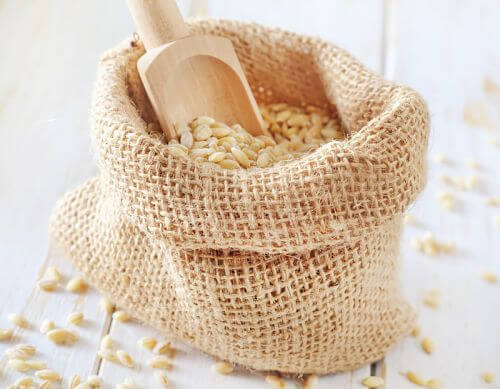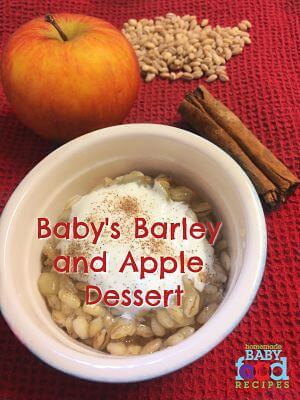Barley Baby Food Recipes – How to Make Barley Baby Cereal and Lots More!
Updated: Oct 17th, 2023
With these barley baby food recipes and tips for introducing barley to baby, you’ll discover how easy it is to include this nutritious grain into your baby’s diet.
Why barley is good for your baby
It may be a somewhat unfashionable food these days, but barley is one of the most nutritious grains out there!
Eating barley is believed to help regulate blood sugar, lower cholesterol and prevent heart disease and certain types of cancer.
Interestingly, research has shown that it is also useful in protecting against childhood asthma.
It contains amino acids, lots of fibre (ounce for ounce, three times as much fibre as oatmeal), B vitamins, iron, selenium, copper, manganese and phosphorus.
When can my baby eat barley?
Barley contains gluten, the protein which gives it its chewy texture and which is also contained in wheat and rye.
Many experts recommend waiting until baby is around 6 months of age before introducing gluten.
For this reason, it’s best to wait until your baby is at least 6 months old before introducing barley.
You should never offer it as a ‘first’ food to your baby if there is a family history of Celiac disease.
You should also be extra careful about introducing barley if your baby is allergic to wheat, as there may be a relationship between barley allergy (which is quite rare) and wheat allergy.
Remember – you should always discuss the introduction of ANY new foods with your child’s doctor, as there may be a specific reason why a particular food isn’t right for him.
Making barley baby food – What are the different types of barley?
Barley is sold in various forms, some of which are more nutritious than others!
Hulled barley (also known as dehulled barley or barley groats)
This is a whole grain and the most nutritious type of all, because only the inedible outer hull of the grain has been removed and the bran and germ are intact.
It is chewier in texture than the types of barley listed below and takes longer to cook.
(Check out our post about another variety – hull-less barley)
Pot barley (also known as scotch barley)
This undergoes an extra step of processing, where it is ‘polished’ to removed to remove the outermost layer of the hull.
Subsequently, it’s less nutritious than hulled barley but cooks more quickly.
Pearl (or pearled) barley
This is the least nutritious form of the grain – and, ironically, the easiest to find in stores!
During polishing, the bran layer is removed, along with some of the endosperm.
It is easier to cook than hulled or pot barley, less chewy and the most popular with consumers.
Barley flakes
The barley is flattened then sliced, giving a product that resembles rolled oats.
Different varieties of barley flakes have differing nutritional value, depending on whether they were produced from hulled or pearled barley.
Barley grits
Difficult to find in stores, barley grits are made by toasting and cracking barley grains.
Again, their nutritional value depends on the type of barley (hulled or pearled) used to make them.
Barley meal
This is a whole grain flour and a very healthy substitute for wheat flour.
Check that it has been produced from whole barley in order to receive the maximum nutritional benefit!
Pearled barley tends to be widely available in grocery stores but – for the more nutritious varieties – you may need to visit your local natural health store.
Barley is often sold loose, in bulk bins.
If you buy barley from bulk bins, make sure it’s from a store that’s busy – this will ensure that the stock gets rotated frequently and the barley hasn’t been sitting there for weeks on end!
Check, too, that the bins are hygienically covered.
Keep your barley in an airtight container at home.
If you buy hulled or pot barley, you should keep it in the fridge.
This is because it contains the oily germ, which may turn rancid in warm conditions.
How to cook barley for your baby
If you buy pre-packed barley, there will usually be cooking instructions provided on the packaging.
Otherwise, the general rule is to use one cup of barley to 3 cups of water.
Just bring the water to a rolling boil, add the barley, bring the liquid back to the boil, then lower the heat and simmer.
Pearled barley requires less water – around 2 cups of water to one cup of barley – and cooks in around 40 minutes.
Pot barley takes around an hour to cook and hulled barley takes around 1 1/2 hours.
A little barley goes a long way… 1 cup of uncooked barley produces around 3 to 4 cups cooked!
Want your baby’s barley to cook faster AND be easier to digest?
Then try soaking it first, which not only increases its digestibility but also makes its nutrients more ‘bio-available’ (easy for the body to absorb).
To do this, place the desired amount of barley in a bowl and cover with twice as much water (i.e. one cup of barley to 2 cups of water).
Leave to soak for several hours (or just leave it overnight), then drain and rinse.
If you don’t plan to cook with it straight away, then put it in a covered container and store in the fridge for up to 2 days.
Barley food ideas and recipes
Barley has a yummy, almost nutty flavour and you can add it to lots of different baby food dishes, immediately boosting their nutritional value.
It’s incredibly versatile and can be used to make breakfast (recipe below), savoury dishes or even dessert!
You can easily add it to soups and stews, making them more satisfying as well as more nutritious, or you can simply serve it as a side dish instead of rice or pasta.
Barley Baby Cereal
2 oz (1/4 cup) ground barley*
12 fl oz (1 1/2 cups) water
*You can grind barley in a good food processor, or with a grain grinder. We find that grinding in small batches gives a better result.
- Pour the water into a small saucepan and bring to the boil.
- Add the powdered barley, stirring constantly.
- Bring back to the boil, then reduce the heat and simmer gently for around 15 to 20 mins.
An alternative to grinding the barley is to simply cook it in the regular way, then place the cooked barley in a food processor and blend with enough breast milk or formula to give the desired consistency.
However you cook it, stirring in some mashed banana will sweeten the barley – you can also try mixing it with other fruit purees and finishing with a nice blob of homemade yogurt for extra creaminess!
Lamb Stew With Barley (7 months+)
1 lb boneless lamb, cubed
2 tsp flour
2 tsp olive oil
2 small carrots (peeled if not organic) and sliced
4 oz (1/2 cup) barley – you can use pearled, but hulled would be better if available
16 fl oz (2 cups) homemade chicken stock
Toss the cubed lamb in the flour until thoroughly coated.
- Heat the oil in a saucepan, then add the lamb cubes and cook, stirring, until browned.
- Remove the lamb with a slotted spoon and add the carrots.
- Cook for a few minutes, stirring from time to time.
- Return the lamb to the pot and stir in the barley and chicken stock.
- Bring to the boil, then lower the heat and simmer for 45 mins, until most of the liquid has been absorbed and the lamb is cooked through.
- Puree or chop well then serve with mashed potato or brown rice.
Baby’s Baked Barley
Using stock in this recipe instead of water gives the barley a slightly different taste, which might appeal to your baby more than ‘regular’ barley!
8 oz (1 cup) pre-soaked hulled barley
1 tbsp olive oil
20 fl oz (2 1/2 cups) vegetable, chicken or beef stock
- Preheat the oven to 375 deg F (190 deg C).
- Put the barley into a baking dish, then pour in the stock and stir.
- Cover and bake for around 1 hour (or 30-40 minutes if you used pearled barley instead of hulled).
- Fluff with a fork and serve as a side dish.
Vegetarian Barley Filled Sweet Potatoes (8 months+)
2 oz (1/4 cup) hulled barley (or pearled if hulled is unavailable)
2 tbsp chopped onion
2 tbsp chopped celery
2 tbsp grated carrot
butter
6 fl oz (3/4 cups) vegetable stock
pinch dried thyme
1 medium sweet potato
- Melt 1 tbsp butter in a saucepan over a medium heat and add the barley, onion and veggies.
- Cook until the barley looks golden.
- Pour in the broth and add the thyme.
- Bring to the boil.
- Reduce the heat and simmer, covered, for 1 1/4 to 1 1/2 hours (for hulled barley) or 40-50 mins (for pearled barley), until the barley is tender and has absorbed the liquid.
- Meanwhile, prick the sweet potato and bake at 375 deg F (190 deg C) for around 45 mins to 1 hour until tender.
- Remove from oven, cool briefly, then cut in half lengthwise.
- Scoop out the flesh, mix with the barley mixture and pile into the skins.
- Lower the oven temperature to 350 deg F (180 deg C) and bake the filled sweet potato skin for a further 20 mins. Cool and serve!
Apple and Banana Barley Dessert (6 months+)
2 tbsp cooked barley
2 tbsp applesauce
1/2 small, ripe banana, mashed
2 tsp natural yogurt
- Combine all the ingredients and chill.
Serve ‘as is’, or blend the mixture in a food processor for a smooth, creamy and nutritious treat.
From our blog…
Homemade baby food equipment…
Homemade baby food accessories



